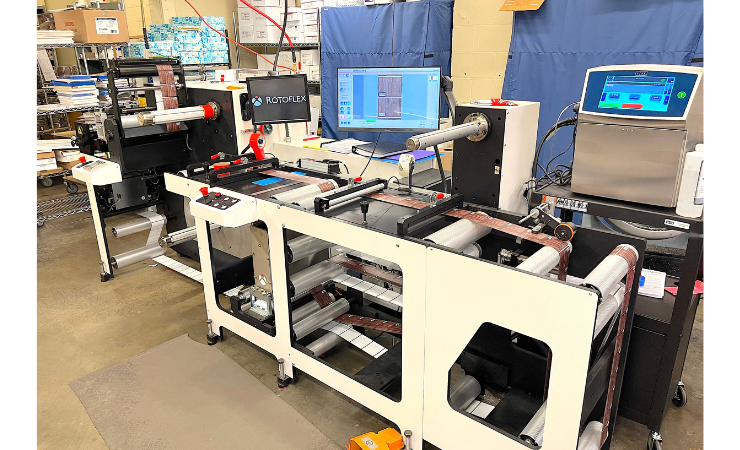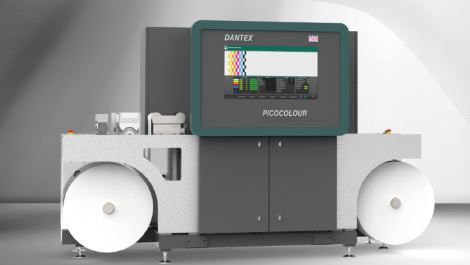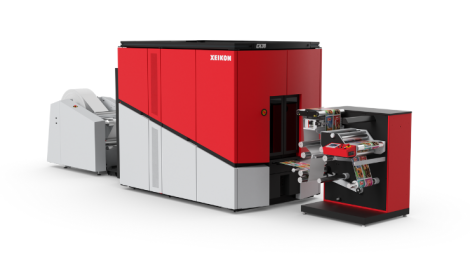Queen City Printing (QCP) has upgraded its Mark Andy Digital One toner-flexo hybrid press to the Digital Pro 3 with inline converting.
To remove the bottleneck in its finishing department, it has also added a Rotoflex HIS 330 inspection rewinder, which the company claims has given it four times the capability with 100% inspection.
Located in Norwood, Cincinnati, QCP was acquired by the late Luigi LaValle III in 1987 and is now under the stewardship of company president Ron Busch.
QCP’s 10,000sq/ft production facility houses a range of print and finishing technology that allow it to offer a large portfolio of products, however it’s in the pressure-sensitive narrow web market that the company has seen major growth, and most of its technology is Mark Andy branded.
‘We started with a 7in five-colour Comco Cadet back in 1990 and haven’t looked back – in fact the Cadet is still running and producing good quality roll-to-roll jobs for the pharmaceutical sector,’ said Mr Busch.
In the mid-1990s, the company saw a growth in demand for sheeted wet glue labels and installed two digital presses, but it was the move by the chemical industry – which provides much of the company’s business – towards roll labels, that prompted Mr Busch to investigate what options were available.
‘It was Labelexpo in 2016 that we started talking with Mark Andy and ended up installing one of its Digital One flexo-toner hybrids in early 2018. It was unique in offering both types of print and converting/finishing inline for single-pass operation – it was tailor-made for our work,’ he explained. In 2019, with the elderly Cadet at full stretch and demand for flexo work showing no signs of slowing, QCP installed a Mark Andy Performance Series P4 press. Its wider 13in web, sixth colour and higher running speed significantly extended the company’s flexo capacity.
Two years on, it became clear that the Digital One was not providing sufficient capacity to meet the demand for short run digital labels, and the decision was made to replace it with a second series machine – the Mark Andy Digital Pro. Essentially a grown-up version of its predecessor, Digital Pro offers a higher running speed, the option of a flexo unit before as well as after the toner engine and a choice of full or semi-rotary die-cutting units. Its 13in web width and 23m/min performance at 1200dpi resolution are notable upgrades. It has a simple and easy to use RIP for handling existing PDFs, requires no clean-room environment and comes complete with an air-cooled LED/UV unit.
‘The ability to lay down a flexo white before overprinting CMYK toner on filmic materials has been a real benefit. We use the second flexo unit for security numbering on the reverse for pharma labels and have both types of die station so that we can choose whichever is best for each job,’ Mr Busch explained.
‘The decision to upgrade was a complete ‘no- brainer’ as far as we are concerned, and while we run mostly self-adhesive stocks on it, it does a brilliant job on the vinyl we use for the industrial market.’ With the increasing use of BOPP and especially silver BOPP, the company has had issues with static electricity build-up, which has been resolved by locating humidifiers strategically around the production area.
One change brought about by the Covid pandemic was the switch by many from paper to PET liners, which run better on all the label presses. ‘The pandemic added about 20% to our sales because we had both substrate and press time available when others did not – it’s fallen back a little, but the market has changed because of different consumer shopping habits, and we are feeling the benefit,’ added Mr Busch.
With press capacity now meeting demand, the bottleneck post press, especially with inspection and rewinding, needed relieving. Once again QCP turned to a Mark Andy product, in this case Rotoflex and an HSI 330 model. The HSI is an operator-friendly machine with a horizontal table.
Mr Busch commented, ‘It’s given us four times the capacity we had before and the advantage of 100% inspection before and after the rewinding, which is essential for our pharma work. It’s easy to use and offers us the ability to vary tension in the rewound rolls – some customers prefer a tightly wound roll, for example in the industrial sectors, while our pharma customers prefer a more loosely wound roll.’
Although it was a recent installation, he claimed it has already made a major contribution to efficiency post-press and completely removed production hold-ups.
Mr Busch concluded that by closely observing a strict manufacturing procedure there is less pressure on staff and fewer opportunities for error. ‘I’m not saying we always get everything right, but if there is an issue, we can quickly identify and rectify it – the Rotoflex is a perfect fit for that.’




